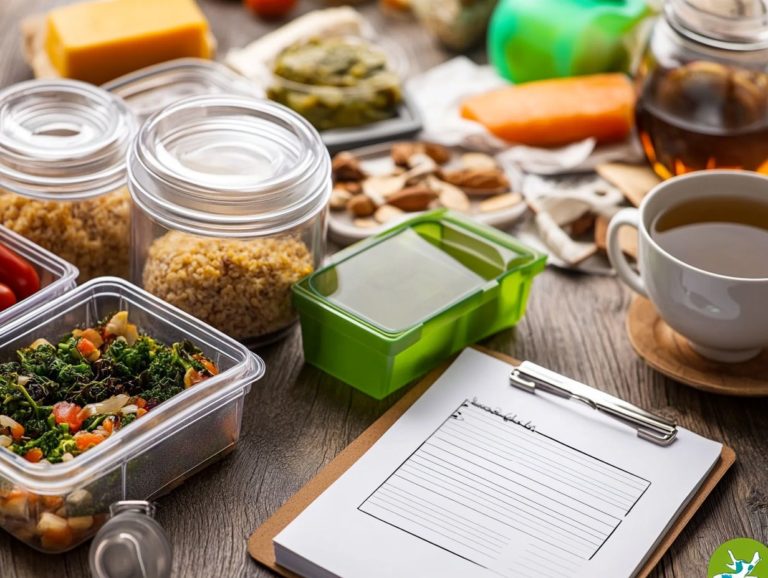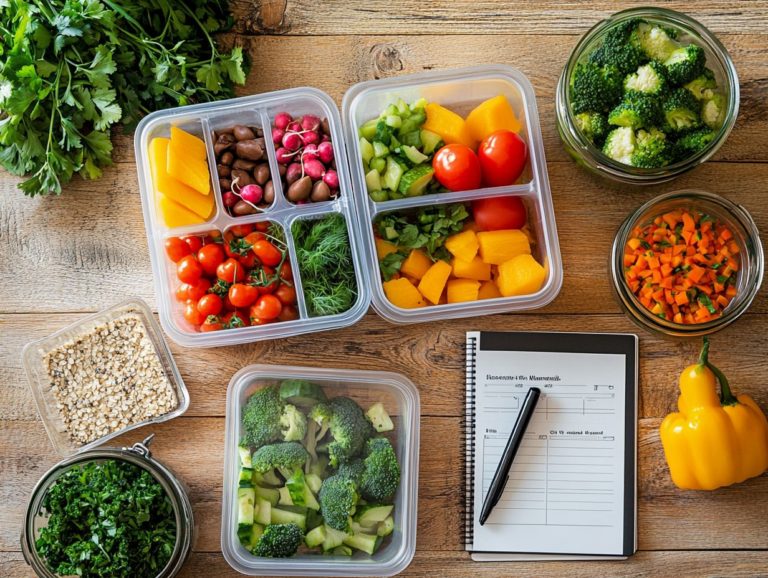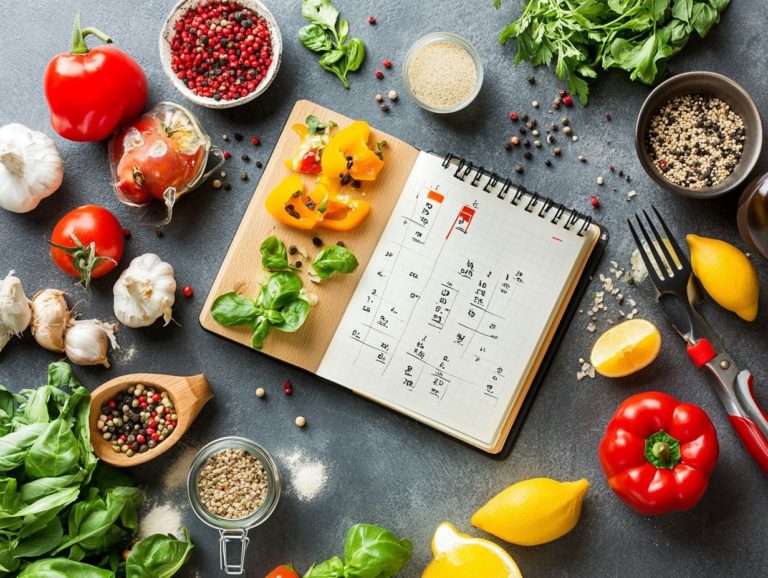5 Best Practices for Healthy Meal Planning
Meal planning can revolutionize your eating habits. It makes your meals healthier, more efficient, and genuinely enjoyable.
This article covers five best practices to help you set realistic goals and choose nutritious foods for your busy days.
You will learn to add variety to your meals and listen to your body’s signals. Plus, we ll share essential tips and common pitfalls to avoid.
You will discover how meal planning supports weight management while saving you time and money.
Dive into this guide and transform your meal planning today!
Contents
- Key Takeaways:
- 1. Set Realistic Goals
- 2. Choose Healthy Foods
- 3. Plan Ahead for Busy Days
- 4. Incorporate Variety in Your Meals
- 5. Listen to Your Body
- Why You Should Start Meal Planning Today!
- Frequently Asked Questions
- What are the 5 best practices for healthy meal planning?
- Why is it important to include a variety of whole foods in meals?
- How can meal planning help with weight management?
- Is it necessary to incorporate all food groups in healthy meal planning?
- Why is sticking to appropriate portion sizes important for healthy meal planning?
- How can limiting processed and high-fat foods benefit your health?
Key Takeaways:

- Set achievable meal planning goals, like adding more fruits and veggies or cutting back on processed foods.
- Choose healthy foods like lean meats, whole grains, and plenty of fruits and vegetables to create balanced meals.
- Prepare meals and snacks ahead of time to make sticking to your healthy meal plan easier.
1. Set Realistic Goals
Setting realistic goals is key to developing healthy eating habits. Make sure your meal prep matches your cooking skills and available time to reduce stress, and avoid common pitfalls by learning from the 5 meal planning mistakes.
Start by assessing your cooking abilities. This will help you create achievable targets that fit your lifestyle and preferences.
Involve your family in meal planning. This teamwork encourages everyone to invest in healthier eating.
2. Choose Healthy Foods
Selecting healthy foods is essential for a balanced meal plan, and incorporating 5 essential tips for meal prepping successfully can ensure that your meals are both nutritious and enjoyable.
Incorporate a mix of fruits, vegetables, whole grains, and healthy fats for balanced nutrition. Imagine a colorful salad with mixed greens, cherry tomatoes, and avocado, all drizzled with olive oil!
Explore local farmers markets for fresh, seasonal produce. This makes it easy to prepare tasty meals with peak flavor.
3. Plan Ahead for Busy Days
Planning ahead is crucial for building a healthy meal habit. By organizing your cooking schedule with the right tools, you can ensure that nutritious meals will be readily available. Check out these essential tools for successful meal planning.
Set aside one day a week for meal prep Sunday is a great choice! This routine helps streamline your cooking process.
Use clear, labeled containers for portion control. On busy days, consider quick, healthy takeout options, like a grilled chicken salad or grain bowl, to stay on track.
4. Incorporate Variety in Your Meals
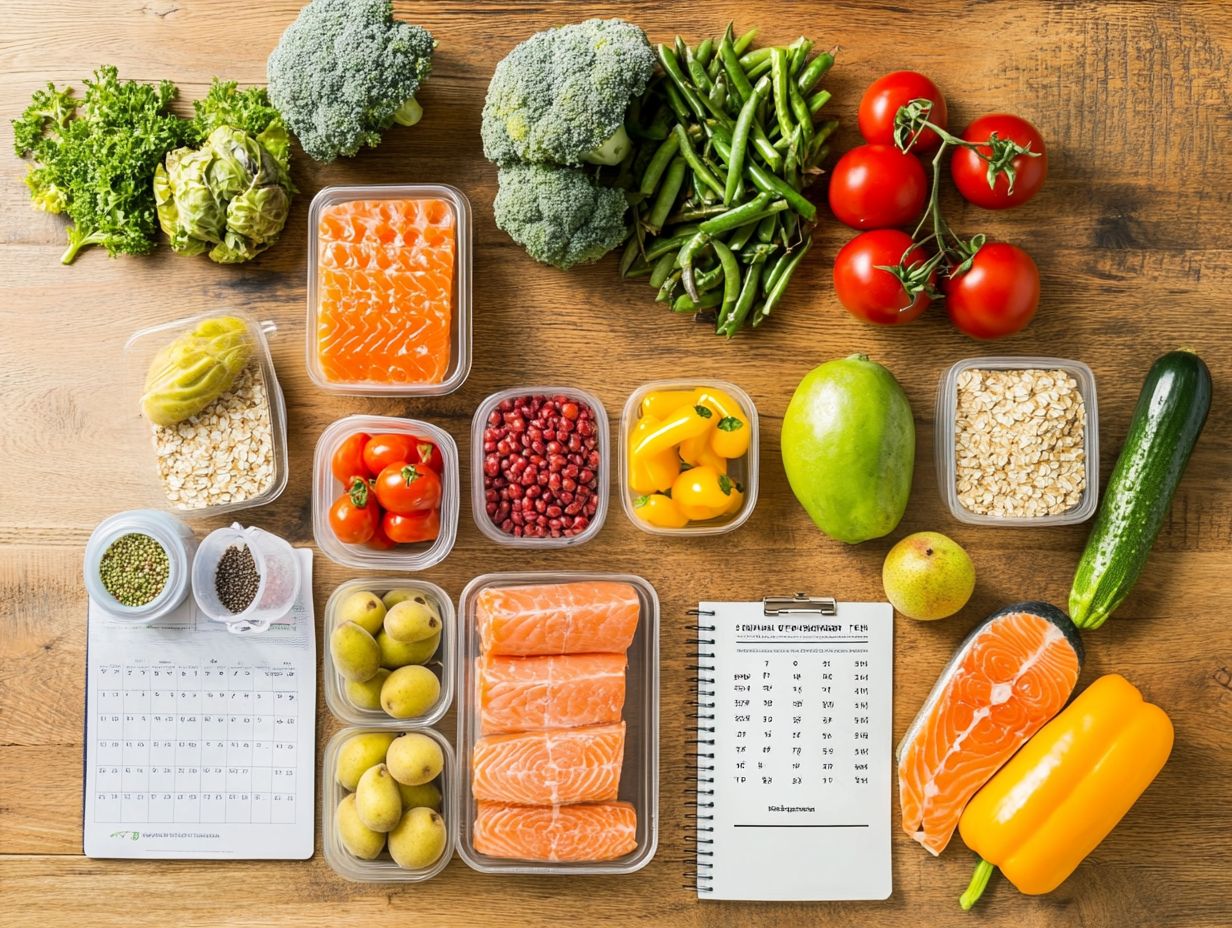
Incorporating variety in your meals is essential for keeping your diet interesting and enjoyable. This practice allows you to explore different cooking techniques and food groups while minimizing waste through creative use of leftovers.
By embracing a diverse range of ingredients from vibrant seasonal vegetables to protein-rich legumes and whole grains you can elevate both the flavor and nutritional content of your dishes. Utilizing various cooking methods, such as grilling, steaming, or roasting, enhances texture and helps you appreciate the unique qualities of each ingredient.
Regarding leftovers, think beyond simple reheating. For example, yesterday’s roasted vegetables can be transformed into a delightful frittata or a hearty soup. This reduces waste and infuses freshness into your meals while fostering a balanced diet and keeping your culinary routine exciting.
5. Listen to Your Body
Listening to your body is essential for healthy eating. It helps you understand your hunger cues and adjust portion sizes according to recommended daily amounts of food that keep you healthy.
This awareness enhances your cooking skills. By knowing when to eat and which foods satisfy your hunger, you can make informed choices that nourish you rather than deplete your energy.
Preparing meals that cater to your body s needs often requires mastering techniques that prioritize healthy ingredient selection and proper portioning. Emphasizing mindful cooking allows you to experiment with flavors while keeping everything affordable and nutritionally sound.
Ultimately, refining these skills can lead to a more satisfying eating experience that honors both your body and your palate.
Why You Should Start Meal Planning Today!
Meal planning presents a wealth of advantages, allowing you to alleviate the stress that often comes with grocery shopping and cooking. It enhances your time management skills and promotes healthier eating habits through intentional choices and budget-friendly meals.
Meal planning significantly improves organization in your kitchen by streamlining grocery lists and ensuring that ingredients are used efficiently. This ultimately minimizes food waste.
This thoughtful approach paves the way for you to explore new, nutritious recipes tailored to your dietary preferences and goals. By customizing your meal plans to fit your unique tastes, you unleash your creativity in the kitchen and strengthen your commitment to healthier choices.
Start planning your meals this week to enjoy better health!
How Can Meal Planning Help with Weight Management?
Meal planning serves as a powerful tool for weight management, allowing you to take control of portion sizes and adhere to nutritional guidelines. Following these 5 essential steps to create a balanced meal promotes healthier eating habits over time and can also help you stretch your budget.
Thoughtfully preparing specific meal portions aids in regulating your caloric intake. This makes it easier to align with your personal dietary goals. Incorporating a variety of food groups ensures that your meals are balanced, providing essential nutrients while curbing the temptation to overindulge.
For instance, using smaller plates can create a visual illusion, making you feel satisfied with less food. Having pre-prepared snacks, like sliced veggies or portioned nuts, at hand can help you resist impulsive choices.
This structured approach supports effective weight management and fosters sustainable habits that lead to long-term success in maintaining a healthy lifestyle.
Tips for Making Healthy Meal Choices
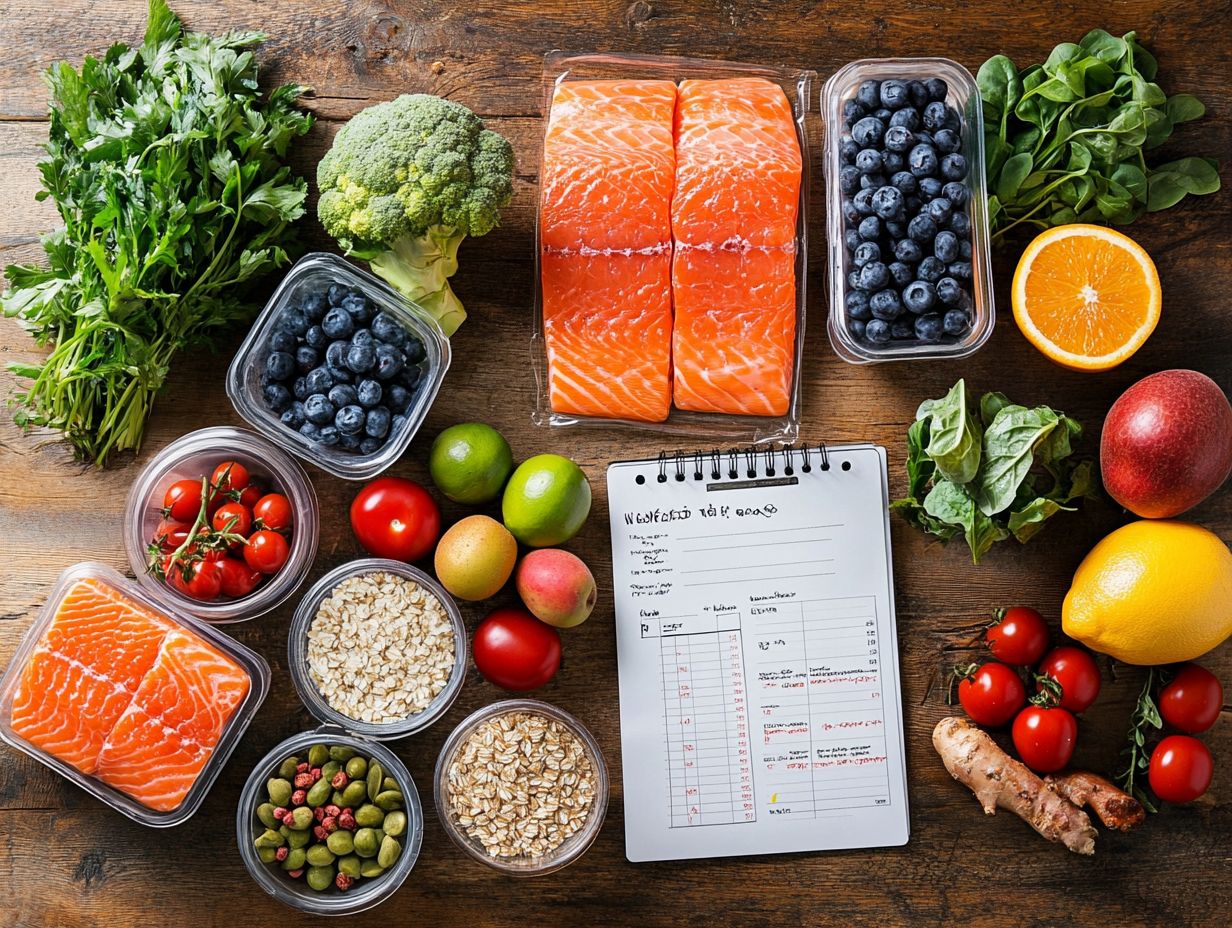
Making healthy meal choices begins with crafting a well-structured meal plan that brings together different types of food. By avoiding common meal planning mistakes and utilizing recipe links along with effective cooking techniques, you can create nutritionally balanced dishes that truly satisfy.
To ensure these meals meet your specific nutritional needs, start by carefully evaluating ingredient labels. Look for key nutrients like fiber, protein, and healthy fats to guide your selections. Additionally, consider 5 strategies for last-minute meal planning to maximize your options. Never underestimate the power of variety; employing different cooking methods such as grilling, steaming, and sautéing can enhance both flavor and texture, catering to a range of food preferences.
It’s wise to choose recipes that effectively balance carbohydrates, proteins, and fats, making sure your meals are both satisfying and nourishing. Using seasonal ingredients adds freshness to your meals and significantly boosts their overall health benefits.
How Can Meal Planning Save Time and Money?
Meal planning is a game-changer for saving both time and money. Make sure every ingredient you buy is used effectively by organizing your grocery lists and managing your food inventory thoughtfully. This elevates your grocery shopping experience and embraces budget-friendly meals.
With a systematic approach, you can minimize unnecessary waste. One effective strategy is batch cooking preparing larger portions of meals to store for later. This means you can enjoy quick, hassle-free dinners during busy weekdays instead of scrambling to start from scratch.
Getting creative with your leftovers is another way to add excitement to your menu while maximizing your budget. By incorporating structured cooking schedules, you can refine your approach, ensuring that each meal aligns with your dietary needs and preferences while streamlining your overall cooking process.
Common Pitfalls to Avoid When Meal Planning
When you embark on meal planning, it’s crucial to steer clear of common pitfalls like underestimating cooking time, overlooking food waste, and failing to consider your cooking skills and portion control. Following 5 steps to create a balanced meal plan can help you navigate these challenges effectively.
Many people forget to weave flexibility into their plans, which can lead to frustration when life’s surprises pop up. Poor food storage practices can also contribute to the deterioration of ingredients, resulting in unnecessary waste and empty pockets. To tackle these challenges, create a realistic schedule that accurately reflects your true cooking times and aligns with your skill level.
Implementing a reliable food storage system think airtight containers for perishables can help keep your ingredients fresh and minimize waste. Embracing these strategies elevates your meal prep experience into a more enjoyable and efficient endeavor.
How Can Meal Planning Be Made More Enjoyable?
Making meal planning enjoyable hinges on your family s involvement and sharing the cooking responsibilities. This allows everyone to contribute their food preferences and creative meal ideas, all while enhancing their cooking skills.
Cooking together can turn meal prep into a fun family event! For instance, establishing theme nights can spark excitement whether it’s Taco Tuesday or Italian Night, these themes encourage creativity in menu selection. Collaborative cooking sessions offer unique opportunities for learning and bonding as everyone experiments with new recipes together.
Incorporating vibrant ingredients and fun utensils fosters a playful atmosphere, inviting each person to add their unique flair. Engaging in shared decision-making about meals instills a sense of ownership and pride, making the entire process not just about the food but about building lasting connections.
Frequently Asked Questions

What are the 5 best practices for healthy meal planning?
The 5 best practices for healthy meal planning are:
- Include a variety of whole foods in your meals
- Plan your meals ahead of time
- Incorporate all food groups in balanced proportions
- Stick to appropriate portion sizes
- Limit processed and high-fat foods
Why is it important to include a variety of whole foods in meals?
Whole foods are packed with essential nutrients, fiber, and antioxidants. These elements are important for staying healthy and preventing chronic diseases.
How can meal planning help with weight management?
Meal planning allows you to control your portion sizes and choose nutritious, balanced meals. By learning how to meal plan for a healthy lifestyle, you can effectively avoid impulsive and unhealthy food choices.
Is it necessary to incorporate all food groups in healthy meal planning?
Yes, it’s crucial to include all food groups in healthy meal planning. Each food group provides unique essential nutrients that your body needs to thrive.
Why is sticking to appropriate portion sizes important for healthy meal planning?
Eating appropriate portion sizes helps with weight management and prevents overeating. It also ensures that you consume a balanced diet with all the necessary nutrients.
How can limiting processed and high-fat foods benefit your health?
Processed and high-fat foods can often be high in calories, unhealthy fats, and added sugars. Limit these foods in your meal planning! You’ll not only feel better but also lower your risk of serious health issues.


